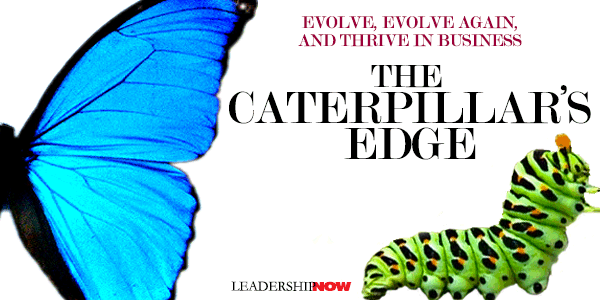 |
 |
03.24.17

The Caterpillar's Edge
T Sid Mohasseb writes in The Caterpillars Edge that “to realize an improved future you must purposefully leave the past behind, and embrace the uncertainty ahead—constantly and without fear. You must evolve, then evolve again and thrive.” The problem as Mohasseb sees it is that many leaders are stuck in their approach to planning and execution. “They are guided by old habits formed in an era when competition was more static.” The data you are using can’t be captured in a fixed plan or you’ll have an excellent strategy for the year before. Your planning and execution needs to be more dynamic than that. We need a new and more agile approach. “The world will not wait while you contemplate, take time to gather enough data to be exhaustive in your analysis, and then build consensus around actions.” You can improve your “likelihood of winning by constantly reading and applying the incoming data points.” “You must learn and live and compete in an uncertain and always changing reality.” Prefer change to the comfort of stability. There are three crucial rules to be applied here: 1. Align with Uncertainty—Adjust to the dynamic world around you. Be prepared to shift your focus at all times. The market is shifting. By the time you transform, the advantage you wanted may be long gone. 2. Appreciate Reality—Understand what is practical and achievable by you and your company. You can evolve over and over. 3. Aspire for More—Seek more data, more analysis, and more “Aha” moments or move faster to reach the moments of insight, where the solutions to problems become clear. McKinsey reports that eight out of ten times strategists focus on known hypothesis—opportunities that have been examined in the past or are already evident. “Most people use analytics in the context of consumer-level transactions. But there is no lasting strategic advantage. When people claim that they are competitive because they are using analytics, that’s just the flavor of the day. Now unless you tell me that you have used data analytics in order to find a new product ground, a new design, and a new market, you are not strategic . . . as opposed to let’s sell more shoes to the guys who are buying shoes . . . what is being done for the most part today is a kind of a tit for tat, and that’s what I see most people calling gaining competitive advantage.” Optimizing today’s processes for greater efficiency does not necessarily offer an advantage for tomorrow. Use the force and create the future. Don’t use the data to justify your actions, use it to discover advantages. It’s not the analytics, but the execution. Analytics is just and tool and soon will be found and used by everyone everywhere. As that occurs, the “business basics of good strategy and execution will, once again, drive the lasting victories.” A winning strategy must be adaptable from the start. Be prepared to improvise. Selected Caterpillar Edge advice:

Posted by Michael McKinney at 12:34 PM
|
BUILD YOUR KNOWLEDGE
 

How to Do Your Start-Up Right STRAIGHT TALK FOR START-UPS 
Grow Your Leadership Skills NEW AND UPCOMING LEADERSHIP BOOKS 
Leadership Minute BITE-SIZE CONCEPTS YOU CAN CHEW ON 
Classic Leadership Books BOOKS TO READ BEFORE YOU LEAD |